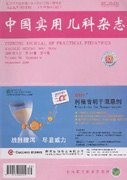|
Efficacy of Saccharomyces boulardii in the prevention of diarrhea secondary to pneumonia in children:A randomized controlled multicenter clinical study
Clinical Research Collaboration Group on the Prevention of Diarrhea Secondary to Pneumonia in Children by Saccharomyces boulardii
2020, 35(11):
866-871.
DOI: 10.19538/j.ek2020110610
Objective To evaluate the clinical efficacy of Saccharomyces boulardii in preventing diarrhea secondary to pneumonia in children. Methods A multi-center,randomized,open and blank control study was conducted,and 499 children aged 1 month to 6 years old with pneumonia were enrolled,who were treated in 18 hospitals in Zhejiang province from August 2014 to December 2017. The children were randomly divided into control group and study group by random number table. The study group was treated with antibiotics plus symptomatic treatment plus Saccharomyces boulardii orally,while the control group was treated with antibiotics plus symptomatic treatment. The usage of Saccharomyces boulardii was 1 pack/time,1 time/day for children aged from 1 month to 3 years old and 1 pack/time,2 times/day for children aged from 3 to 6 years old. The children were followed up until 14 d after withdrawal of antibiotics. Observe and record the times of bowel movement and stool property. The results,such as the incidence of diarrhea,the antibiotic use time,the hospitalization time,the hospital costs and adverse drug reactions,were observed and recorded. Results Totally 499 cases were randomly divided into two groups,among which report of 434 cases were received,and 370 cases were included for effect analysis(192 cases in the study group,178 cases in the control group). There was no significant difference in general information between the two groups. The overall incidence of secondary diarrhea in the study group was lower than that in the control group(P=0.017 < 0.05). There was no significant difference between the two groups in terms of the antibiotic use time,hospitalization time or hospital costs. Stratified analysis of age found that when the age of children was less than or equal to 1 year old,there was no significant difference in the incidence of diarrhea between the two groups,but when the age of children was more than 1 year old,the incidence of diarrhea in the study group was significantly lower than that in the control group(P=0.006 < 0.05). Stratified analysis of antibiotics showed there was no significant difference in the incidence of diarrhea between the two groups. Multivariate Logistic regression analysis showed that the age and duration of antibiotic treatment were risk factors,but Saccharomyces boulardii was a protective factor. No drug-related adverse events were observed in both groups. Conclusion Saccharomyces boulardii can prevent diarrhea secondary to pneumonia in children without obvious adverse reactions.
|

